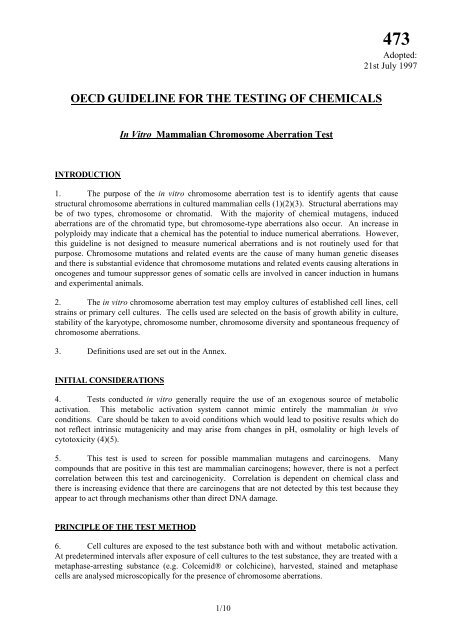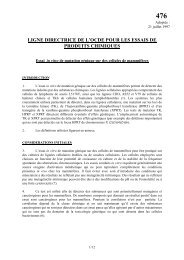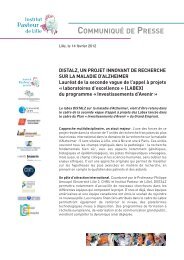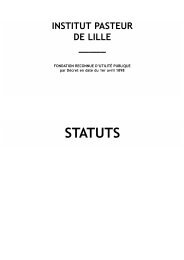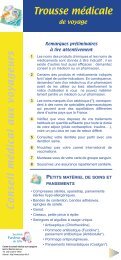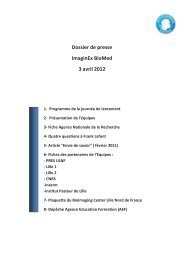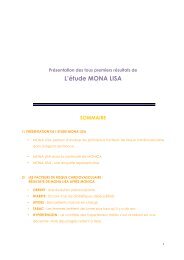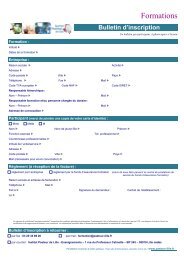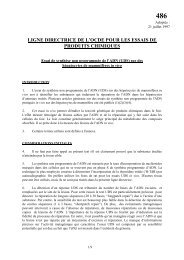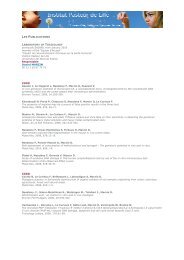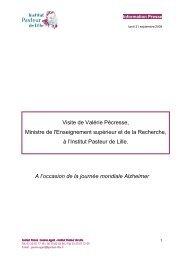OECD GUIDELINE FOR THE TESTING OF CHEMICALS
OECD GUIDELINE FOR THE TESTING OF CHEMICALS
OECD GUIDELINE FOR THE TESTING OF CHEMICALS
Create successful ePaper yourself
Turn your PDF publications into a flip-book with our unique Google optimized e-Paper software.
473 <strong>OECD</strong>/OCDEDESCRIPTION <strong>OF</strong> <strong>THE</strong> METHODPreparationsCells7. A variety of cell lines, strains or primary cell cultures, including human cells, may be used(e.g. Chinese hamster fibroblasts, human or other mammalian peripheral blood lymphocytes).Media and culture conditions8. Appropriate culture media, and incubation conditions (culture vessels, CO 2concentration,temperature and humidity) should be used in maintaining cultures. Established cell lines and strainsshould be checked routinely for stability in the modal chromosome number and the absence ofmycoplasma contamination and should not be used if contaminated. The normal cell cycle time forthe cells and culture conditions used should be known.Preparation of cultures9. Established cell lines and strains: cells are propagated from stock cultures, seeded in culturemedium at a density such that the cultures will not reach confluency before the time of harvest, andincubated at 37°C.10. Lymphocytes: whole blood treated with an anti-coagulant (e.g. heparin) or separatedlymphocytes obtained from healthy subjects are added to culture medium containing a mitogen (e.g.phytohemagglutinin) and incubated at 37°C.Metabolic activation11. Cells should be exposed to the test substance both in the presence and absence of anappropriate metabolic activation system. The most commonly used system is a co-factorsupplementedpost-mitochondrial fraction (S9) prepared from the livers of rodents treated withenzyme-inducing agents such as Aroclor 1254 (6)(7)(8)(9), or a combination of phenobarbitone andß-naphthoflavone (10)(11)(12). The post-mitochondrial fraction is usually used at concentrations inthe range from 1-10% v/v in the final test medium. The condition of a metabolic activation systemmay depend upon the class of chemical being tested. In some cases it may be appropriate to utilizemore than one concentration of post-mitochondrial fraction. A number of developments, includingthe construction of genetically engineered cell lines expressing specific activating enzymes, mayprovide the potential for endogenous activation. The choice of the cell lines used should bescientifically justified (e.g., by the relevance of the cytochrome P450 isoenzyme for the metabolismof the test substance).Test substance/Preparation12. Solid test substances should be dissolved or suspended in appropriate solvents or vehiclesand diluted if appropriate prior to treatment of the cells. Liquid test substances may be addeddirectly to the test systems and/or diluted prior to treatment. Fresh preparations of the test substanceshould be employed unless stability data demonstrate the acceptability of storage.2/10
<strong>OECD</strong>/OCDE 473Test conditionsSolvent/vehicle13. The solvent/vehicle should not be suspected of chemical reaction with the test substanceand should be compatible with the survival of the cells and the S9 activity. If other than well-knownsolvent/vehicles are used, their inclusion should be supported by data indicating their compatibility.It is recommended that wherever possible, the use of an aqueous solvent/vehicle be considered first.When testing water-unstable substances, the organic solvents used should be free of water. Watercan be removed by adding a molecular sieve.Exposure concentrations14. Among the criteria to be considered when determining the highest concentration arecytotoxicity, solubility in the test system, and changes in pH or osmolality.15. Cytotoxicity should be determined with and without metabolic activation in the mainexperiment using an appropriate indication of cell integrity and growth, such as degree of confluency,viable cell counts, or mitotic index. It may be useful to determine cytotoxicity and solubility in apreliminary experiment.16. At least three analysable concentrations should be used. Where cytotoxicity occurs, theseconcentrations should cover a range from the maximum to little or no toxicity; this will usually meanthat the concentrations should be separated by no more than a factor between 2 and √10. At the timeof harvesting, the highest concentration should show a significant reduction in degree of confluency,cell count or mitotic index, (all greater than 50%). The mitotic index is only an indirect measure ofcytotoxic/cytostatic effects and depends on the time after treatment. However, the mitotic index isacceptable for suspension cultures in which other toxicity measurements may be cumbersome andimpractical. Information on cell cycle kinetics, such as average generation time (AGT), could beused as supplementary information. AGT, however, is an overall average that does not always revealthe existence of delayed subpopulations, and even slight increases in average generation time can beassociated with very substantial delay in the time of optimal yield of aberrations. For relatively noncytotoxiccompounds the maximum concentration should be 5 µl/ml, 5 mg/ml, or 0.01M, whicheveris the lowest.17. For relatively insoluble substances that are not toxic at concentrations lower than theinsoluble concentration, the highest dose used should be a concentration above the limit of solubilityin the final culture medium at the end of the treatment period. In some cases (e.g. when toxicityoccurs only at higher than the lowest insoluble concentration) it is advisable to test at more than oneconcentration with visible precipitation. It may be useful to assess solubility at the beginning and theend of the treatment, as solubility can change during the course of exposure in the test system due topresence of cells, S9, serum etc. Insolubility can be detected by using the unaided eye. Theprecipitate should not interfere with the scoring.Controls18. Concurrent positive and negative (solvent or vehicle) controls both with and withoutmetabolic activation should be included in each experiment. When metabolic activation is used, thepositive control chemical should be the one that requires activation to give a mutagenic response.19. Positive controls should employ a known clastogen at exposure levels expected to give areproducible and detectable increase over background which demonstrates the sensitivity of the testsystem. Positive control concentrations should be chosen so that the effects are clear but do not3/10
473 <strong>OECD</strong>/OCDEimmediately reveal the identity of the coded slides to the reader. Examples of positive controlsubstances include:Metabolic activation conditionAbsence of exogenous metabolic activationChemical and CAS No.Methyl methanesulphonate[CAS no. 66-27-3]Ethyl methanesulphonate [CAS no. 62-50-0]Ethylnitrosourea [CAS no. 759-73-9]Mitomycin C [CAS no. 50-07-7]4-Nitroquinoline-N-Oxide [CAS no. 56-57-5]Presence of exogenous metabolic activation Benzo(a)pyrene [CAS no. 50-32-8]Cyclophosphamide (monohydrate)[CAS no. 50-18-0 (CAS no. 6055-19-2)]20. Other appropriate positive control substances may be used. The use of chemical classrelatedpositive control chemicals may be considered, when available.21. Negative controls, consisting of solvent or vehicle alone in the treatment medium, andtreated in the same way as the treatment cultures, should be included for every harvest time. Inaddition, untreated controls should also be used unless there are historical control data demonstratingthat no deleterious or mutagenic effects are induced by the chosen solvent.PROCEDURETreatment with test substance22. Proliferating cells are treated with the test substance in the presence and absence of ametabolic activation system. Treatment of lymphocytes should commence at about 48 hours aftermitogenic stimulation.23. Duplicate cultures should normally be used at each concentration, and are stronglyrecommended for negative/solvent control cultures. Where minimal variation between duplicatecultures can be demonstrated (13)(14), from historical data, it may be acceptable for single culturesto be used at each concentration.24. Gaseous or volatile substances should be tested by appropriate methods, such as in sealedculture vessels (15)(16).Culture harvest time25. In the first experiment, cells should be exposed to the test substance both with and withoutmetabolic activation for 3-6 hours, and sampled at a time equivalent to about 1.5 normal cell cyclelength after the beginning of treatment (12). If this protocol gives negative results both with andwithout activation, an additional experiment without activation should be done with continuoustreatment until sampling at a time equivalent to about 1.5 normal cell cycle lengths. Certainchemicals may be more readily detected by treatment/sampling times longer than 1.5 cycle lengths.Negative results with metabolic activation need to be confirmed on a case-by-case basis. In those4/10
<strong>OECD</strong>/OCDE 473cases where confirmation of negative results is not considered necessary, justification should beprovided.Chromosome preparation26. Cell cultures are treated with Colcemid® or colchicine usually for one to three hours priorto harvesting. Each cell culture is harvested and processed separately for the preparation ofchromosomes. Chromosome preparation involves hypotonic treatment of the cells, fixation andstaining.Analysis27. All slides, including those of positive and negative controls, should be independently codedbefore microscopic analysis. Since fixation procedures often result in the breakage of a proportion ofmetaphase cells with loss of chromosomes, the cells scored should therefore contain a number ofcentromeres equal to the modal number +2 for all cell types. At least 200 well-spread metaphasesshould be scored per concentration and control equally divided amongst the duplicates, if applicable.This number can be reduced when high numbers of aberrations are observed.28. Though the purpose of the test is to detect structural chromosome aberrations, it isimportant to record polyploidy and endoreduplication when these events are seen.DATA AND REPORTINGTreatment of results29. The experimental unit is the cell, and therefore the percentage of cells with structuralchromosome aberration(s) should be evaluated. Different types of structural chromosome aberrationsshould be listed with their numbers and frequencies for experimental and control cultures. Gaps arerecorded separately and reported but generally not included in the total aberration frequency.30. Concurrent measures of cytotoxicity for all treated and negative control cultures in the mainaberration experiment(s) should also be recorded.31. Individual culture data should be provided. Additionally, all data should be summarised intabular form.32. There is no requirement for verification of a clear positive response. Equivocal resultsshould be clarified by further testing preferably using modification of experimental conditions. Theneed to confirm negative results has been discussed in paragraph 25. Modification of studyparameters to extend the range of conditions assessed should be considered in follow-up experiments.Study parameters that might be modified include the concentration spacing and the metabolicactivation conditions.Evaluation and interpretation of results33. There are several criteria for determining a positive result, such as a concentration-relatedincrease or a reproducible increase in the number of cells with chromosome aberrations. Biologicalrelevance of the results should be considered first. Statistical methods may be used as an aid inevaluating the test results (3)(13). Statistical significance should not be the only determining factorfor a positive response.5/10
473 <strong>OECD</strong>/OCDE34. An increase in the number of polyploid cells may indicate that the test substance has thepotential to inhibit mitotic processes and to induce numerical chromosome aberrations. An increasein the number of cells with endoreduplicated chromosomes may indicate that the test substance hasthe potential to inhibit cell cycle progression (17)(18).35. A test substance for which the results do not meet the above criteria is considered nonmutagenicin this system.36. Although most experiments will give clearly positive or negative results, in rare cases thedata set will preclude making a definite judgement about the activity of the test substance. Resultsmay remain equivocal or questionable regardless of the number of times the experiment is repeated.37. Positive results from the in vitro chromosome aberration test indicate that the test substanceinduces structural chromosome aberrations in cultured mammalian somatic cells. Negative resultsindicate that, under the test conditions, the test substance does not induce chromosome aberrations incultured mammalian somatic cells.Test report38. The test report must include the following information:Test substance:- identification data and CAS no., if known;- physical nature and purity;- physicochemical properties relevant to the conduct of the study;- stability of the test substance, if known.Solvent/Vehicle:Cells:- justification for choice of solvent/vehicle;- solubility and stability of the test substance in solvent/vehicle, if known.- type and source of cells;- karyotype features and suitability of the cell type used;- absence of mycoplasma, if applicable;- information on cell cycle length;- sex of blood donors, whole blood or separated lymphocytes, mitogen used;- number of passages, if applicable;- methods for maintenance of cell cultures if applicable;- modal number of chromosomes.Test conditions:- identity of metaphase arresting substance, its concentration and duration of cellexposure;- rationale for selection of concentrations and number of cultures including, e.g.cytotoxicity data and solubility limitations, if available;- composition of media, CO 2 concentration if applicable;- concentration of test substance;- volume of vehicle and test substance added;6/10
<strong>OECD</strong>/OCDE 473- incubation temperature;- incubation time;- duration of treatment;- cell density at seeding, if appropriate;- type and composition of metabolic activation system, including acceptability criteria;- positive and negative controls;- methods of slide preparation;- criteria for scoring aberrations;- number of metaphases analyzed;- methods for the measurements of toxicity;- criteria for considering studies as positive, negative or equivocal.Results:- signs of toxicity, e.g. degree of confluency, cell cycle data, cell counts, mitotic index;- signs of precipitation;- data on pH and osmolality of the treatment medium, if determined;- definition for aberrations, including gaps;- number of cells with chromosome aberrations and type of chromosome aberrationsgiven separately for each treated and control culture;- changes in ploidy if seen;- dose-response relationship, where possible;- statistical analyses, if any;- concurrent negative (solvent/vehicle) and positive control data;- historical negative (solvent/vehicle) and positive control data, with ranges, means andstandard deviations.Discussion of the results.Conclusion.LITERATURE(1) Evans, H.J. (1976). Cytological Methods for Detecting Chemical Mutagens. In: ChemicalMutagens, Principles and Methods for their Detection, Vol. 4, Hollaender, A. (ed) PlenumPress, New York and London, pp. 1-29.(2) Ishidate, M. Jr. and Sofuni, T. (1985). The In Vitro Chromosomal Aberration Test UsingChinese Hamster Lung (CHL) Fibroblast Cells in Culture. In: Progress in Mutation Research,Vol. 5, Ashby, J. et al., (Eds) Elsevier Science Publishers, Amsterdam-New York- Oxford, pp.427-432.(3) Galloway, S.M., Armstrong, M.J., Reuben, C., Colman, S., Brown, B., Cannon, C., Bloom,A.D., Nakamura, F., Ahmed, M., Duk, S., Rimpo, J., Margolin, G. H., Resnick, M. A.,Anderson, G. and Zeiger, E. (1987). Chromosome aberration and sister chromatid exchanges inChinese hamster ovary cells: Evaluation of 108 chemicals. Environ. Molec. Mutagen, 10 (suppl.10), 1-175.(4) Scott, D., Galloway, S.M., Marshall, R.R., Ishidate, M. Jr, Brusick, D., Ashby, J. and Myhr,B.C., (1991). Genotoxicity under Extreme Culture Conditions. A report from ICPEMC TaskGroup 9. Mutation Res., 257, 147-204.7/10
473 <strong>OECD</strong>/OCDE(5) Morita, T., Nagaki, T., Fukuda, I. and Okumura, K., (1992). Clastogenicity of Low pH toVarious Cultured Mammalian Cells. Mutation Res., 268, 297-305.(6) Ames, B.N., McCann, J. and Yamasaki, E. (1975). Methods for Detecting Carcinogens andMutagens with the Salmonella/Mammalian Microsome Mutagenicity Test. Mutation Res., 31,347-364.(7) Maron, D.M. and Ames, B.N. (1983). Revised Methods for the Salmonella Mutagenicity Test.Mutation Res., 113, 173-215.(8) Natarajan, A.T., Tates, A.D, van Buul, P.P.W., Meijers, M. and de Vogel, N. (1976).Cytogenetic Effects of Mutagens/Carcinogens after Activation in a Microsomal System InVitro, I. Induction of Chromosome Aberrations and Sister Chromatid Exchanges byDiethylnitrosamine (DEN) and Dimethylnitrosamine (DMN) in CHO Cells in the Presence ofRat-Liver Microsomes. Mutat. Res., 37, 83-90.(9) Matsuoka, A., Hayashi, M. and Ishidate, M., Jr. (1979). Chromosomal Aberration Tests on 29Chemicals Combined with S9 Mix In vitro. Mutation. Res., 66, 277-290.(10) Elliot, B.M., Combes, R.D., Elcombe, C.R., Gatehouse, D.G., Gibson, G.G., Mackay, J.M. andWolf, R.C. (1992). Report of UK Environmental Mutagen Society Working Party. Alternativesto Aroclor 1254-induced S9 in In Vitro Genotoxicity Assays. Mutagenesis, 7, 175-177.(11) Matsushima, T., Sawamura, M., Hara, K. and Sugimura, T. (1976). A Safe Substitute forPolychlorinated Biphenyls as an Inducer of Metabolic Activation Systems. In: de Serres, F.J.,Fouts, J.R., Bend, J.R. and Philpot, R.M. (eds) In Vitro Metabolic Activation in MutagenesisTesting, Elsevier, North-Holland, pp. 85-88.(12) Galloway, S.M., Aardema, M.J., Ishidate, M.,Jr., Ivett., J.L., Kirkland, D.J., Morita, T.,Mosesso, P., Sofuni, T. (1994). Report from Working Group on in Vitro Tests for ChromosomalAberrations. Mutation Res., 312, 241-261.(13) Richardson, C., Williams, D.A., Allen, J.A., Amphlett, G., Chanter, D.O., and Phillips, B.(1989). Analysis of Data from In Vitro Cytogenetic Assays. In: Statistical Evaluation ofMutagenicity Test Data. Kirkland, D.J., (ed) Cambridge University Press, Cambridge, pp. 141-154.(14) Soper, K.A. and Galloway S.M. (1994). Replicate Flasks are not Necessary for In VitroChromosome Aberration Assays in CHO Cells. Mutation Res., 312, 139-149.(15) Krahn, D.F., Barsky, F.C. and McCooey, K.T. (1982). CHO/HGPRT Mutation Assay:Evaluation of Gases and Volatile Liquids. In: Tice, R.R., Costa, D.L., Schaich, K.M. (eds.)Genotoxic Effects of Airborne Agents. New York, Plenum, pp. 91-103.(16) Zamora, P.O., Benson, J.M., Li, A.P. and Brooks, A.L. (1983). Evaluation of an ExposureSystem Using Cells Grown on Collagen Gels for Detecting Highly Volatile Mutagens in theCHO/HGPRT Mutation Assay. Environmental Mutagenesis, 5, 795-801.(17) Locke-Huhle, C. (1983) Endoreduplication in Chinese hamster cells during alpha-radiationinduced G2 arrest. Mutation Res., 119, 403-413.8/10
<strong>OECD</strong>/OCDE 473(18) Huang, Y., Change, C. and Trosko, J.E. (1983) Aphidicolin - induced endoreduplication inChinese hamster cells. Cancer Res., 43, 1362-1364.9/10


